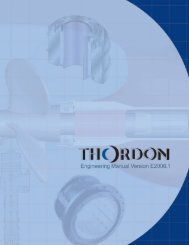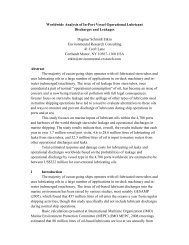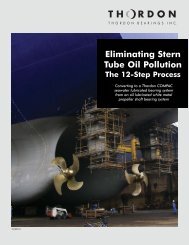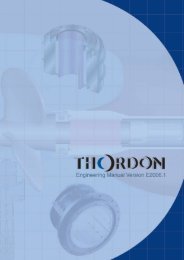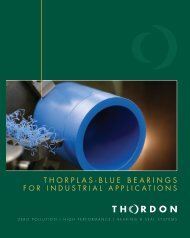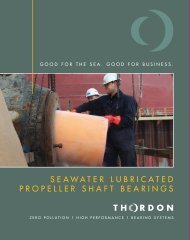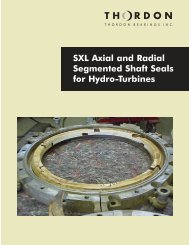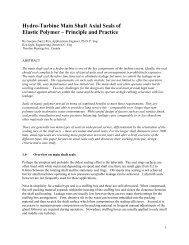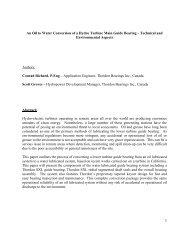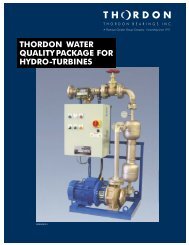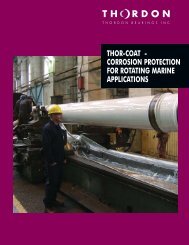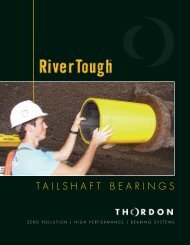Converting An Icebreaker From An Oil ... - Thordon Bearings
Converting An Icebreaker From An Oil ... - Thordon Bearings
Converting An Icebreaker From An Oil ... - Thordon Bearings
Create successful ePaper yourself
Turn your PDF publications into a flip-book with our unique Google optimized e-Paper software.
<strong>Converting</strong> <strong>An</strong> <strong>Icebreaker</strong> <strong>From</strong> <strong>An</strong> <strong>Oil</strong> Lubricated Stern Tube Bearing SystemTo A Seawater Lubricated Stern Tube Bearing Considering Environmental<strong>An</strong>d Operating CostsMr. Ken J. Ogle, C.Eng, MIMarEST.Director of Engineering, <strong>Thordon</strong> <strong>Bearings</strong> Inc.Burlington, Ontario, CANADAkeno@thordonbearings.comandMr. Craig D. Carter, MBADirector of Marketing and Customer Service, <strong>Thordon</strong> <strong>Bearings</strong> Inc.Burlington, Ontario, CANADAcraigc@thordonbearings.comABSTRACTOperational discharges of oil from the stern tube is a commonoccurrence for ice breakers as propellers are prone to impact from icecausing shafts to flex and seals are unable to maintain a completebarrier to keep seawater out or lubricating oil in the stern tube.Whereas solar radiation generally speeds the break-down ofcontaminants, the reduced level of sunlight in the Arctic lengthens thedegradation process and increases the likelihood that toxic substancesin the stern tube lubricating oil will find their way into the food chain.Hence, deemed “biodegradable” lubricants may not be asbiodegradable in the Arctic operating environments. However, thereexists a proven, viable option for vessels operating in the Arctic toeliminate stern tube oil pollution. This paper outlines the process forconverting the sterntube bearings from oil-lubricated white-metalbearings to <strong>Thordon</strong> COMPAC seawater lubricated bearings, based onrecent works on a twin screw ice breaker at a shipyard in Canada.KEY WORDSice breaker; stern tube bearings; propeller shaft bearings; oil pollution;lubricating oil; COMPACINTRODUCTIONIce breakers are an important asset to any ship owner operating in iceconditions, especially during the winter months maintaining northernwaterways. <strong>An</strong>y vessel downtime due to maintenance issues couldmean shipping lanes may not be open. The increased use of icebreakers and number of ships operating in Arctic trading routes haveraised concerns of environmental threats to the Arctic ecosystemsWhile owners implement measures to prevent accidental spills, one ofthe major issues encountered by vessels in ice is the maintenancerequired to the shaft seals that contain oil in the stern tube. Even a newseal must leak a small amount to operate, ice-milling can cause shaftmovements so fast that the sealing elements cannot follow the shaftquickly enough and increased leakage results. Interaction with anyfishing line or similar and seal operation is seriously compromised.It is generally solar radiation that breaks down an oil spill, however thereduced level of sunlight in the Arctic must surely lengthen thedegradation process and increase the likelihood that toxic substancesfrom stern tube lubricating oil will find their way into the food chain.Those biodegradable lubricants may not be so biodegradable after allwhen exposed to the harsh and uncompromising Arctic environments.The trend towards zero tolerance for any kind of ship source pollutioncontinues and international regulations are becoming more stringent,however the Arctic presents a significantly more serious situation.Detection, monitoring, and cleanup are difficult (and consequentlyexpensive in cost and environmental impact) due to climatic conditions,remoteness, and the shifting interplay between land and sea-ice.The simplest way to completely eliminate oil leakage from the sterntube is to use seawater as the lubrication and cooling medium with<strong>Thordon</strong> non-metallic bearings in place of the white metal bearings.The seawater is taken from the sea, pumped through the bearings andreturns to the sea. The seawater enters the forward section of the sterntube immediately aft of the seal. The seawater passes through theforward and then aft bearing prior to re-entering the sea as shown inFigure 1.Paper No. ICETECH10-184-R0 Ogle Page number: 1
showed that surprisingly the vessel did not fully conform to the 1984original build drawings! The variances however were small enoughthat it was possible to accommodate them within the parts alreadysupplied.A piano wire was strung through reference points and measurementsfrom it as a datum were taken to determine the relative position of theshaft within the original bearings – this shaft position would need to bereplicated with the new bearings. The forward and aft white metalbearings were then removed and their geometries verified as paralleland concentric, i.e. they had not been machined with offsets nor slope.Figure 1. <strong>Thordon</strong> COMPAC seawater lubricated stern tube bearingsystemBACKGROUNDFirst discussion between the ship owner and <strong>Thordon</strong> <strong>Bearings</strong>regarding the possible conversion of the closed oil lubricated stern tubewith forward and aft seals to an open water lubricated system with onlya forward seal began in late 2006. The <strong>Thordon</strong> Engineering teamreviewed the existing stern tube and shaft arrangements, bearingdrawings, shaft alignment and load calculations for the ice breaker.The vessel is 70m in length with a breadth of 14m and a draft of 5.2m.There are four main engines each 2210 horsepower (1725kW) coupledin pairs through Valmet gearboxes to drive two Wartsila controllablepitch propellers at maximum shaft speed of 240rpm. The propellersoperate inside nozzles.The major topics reviewed by <strong>Thordon</strong> Engineering included: 1) thatspace was available for fitting of shaft liners to Class requiredthickness, 2) that bearing loads were acceptable to Class limits forwater lubricated bearings and 3) determination of bearing offsets andmachining such as required etc. to maintain the existing shaft centerlinealignment. Once these topics were reviewed and achievable, <strong>Thordon</strong>advised the customer the conversion was possible. The proposal from<strong>Thordon</strong> <strong>Bearings</strong> included the design, supply and installation of<strong>Thordon</strong> COMPAC water lubricated propeller shaft bearings incarriers, bronze shaft liners, Thor-Coat shaft coating, <strong>Thordon</strong> WaterQuality Packages, and forward seals. Arrangement drawings for theconversion project were supplied by <strong>Thordon</strong>.Due to demand for its service, scheduling the ice breaker for a sterntube bearing conversion was a difficult decision for the customer and itwas mid-2009 before the order was placed for all conversion parts from<strong>Thordon</strong>. The vessel was then to drydock in the fall of 2009. It isimportant to note that shaft liners and bearing carriers where needed,can have long delivery lead times so it is prudent to begin the planningof an oil lubricated stern tube conversion to water lubricated <strong>Thordon</strong>COMPAC at an early stage.The stern tubes were stripped of all internal pipeworks which werebecoming redundant with the new water lubricated bearings. The newbearing carriers were entered in the stern tube and the piano wire datumre-established. The carrier design included jacking screws at 120°spacing at each end and these were used to correctly position thecarriers relative to the piano wire.Since the new bearings would have a larger clearance than theoriginals, the carriers needed to be installed offset upwards, by anamount equal to 50% of the clearance difference, to replicate the shaftcenterline alignment.The spaces at ends of the carriers were then dammed and Chockfastorange was injected around the carriers – since this was in Canada andgetting late in the year, heating of the stern tube vicinity was requiredfor the chocking operation. Since curing of the chocking resin isexothermic and COMPAC bearings should not be exposed totemperatures above 60°C (140°F), it is preferable to chock the carriersin place empty. The carrier bores had already been fitted with bronzeanti-rotation keys for the COMPAC bearing elements. After curing ofthe resin, repeat measurements to the piano wire confirmed the carrierpositions were still correct.All stern tube internals were then thoroughly cleaned, sandblasted andpainted with anti-corrosion coating. Note - due to delivery timeconstraints for bronze, the ship owner had opted for mild steel bearingcarriers here so these were also coated, etc.<strong>Thordon</strong> COMPAC bearings had been pre-machined to the designdimensions ready for installation. The bearings were slotted to matewith the anti-rotation keys already fitted in the carriers. The bearingelements were freeze-fitted into the carriers - liquid nitrogen was usedas coolant and only 10-15 minutes immersion time was needed toshrink the bearings enough that they were inserted into the carriers byhand. The retaining rings were then fitted and secured to complete thebearing installation.BEARING CONVERSIONWith the vessel drydocked, all oil was drained from the stern tubesystem and the tailshafts removed. Check measurements from theintermediate shafts to the aft bulkhead and sterntube bearing positionsFigure 2. Retaining ring fitted to COMPAC bearing carrierPaper No. ICETECH10-184-R0 Ogle Page number: 2
The installed bearing must be allowed to thoroughly thaw to ambienttemperature before the bearing bore is measured – preferably, thebearing is left overnight and bore measurements recorded the next day.SHAFT CORROSION PROTECTIONThe steel tailshafts will now be exposed to seawater inside the sterntubes, where previously they had operated in an oil bath - consequentlythey need protection against corrosion.Bronze liners were fitted to the shafts in way of the bearings and theintervening shaft surfaces coated with Thor-Coat, a 2-part epoxy coatedspecially developed by <strong>Thordon</strong> <strong>Bearings</strong> as a marine propeller shaftcoating. The coating is designed to remain flexible to accommodate theshaft bending and torsional strains in service. The liners were ofcentrifugally cast gunmetal, dimensioned and hydrostatically tested allin accordance with Classification Rule requirements – in this caseLloyd’s Register of Shipping.The shafts were cleaned and linished with a 400-grit belt in preparationfor the liners. The liner bores were machined to give 0.5mm (0.020”)interference to the shafts. The liners were heated to 300ºC (570ºF)using electric heating elements and then slid into position on the shaftsand allowed to cool. The aft liner extended to just in front of thepropeller flange radius (the radius was left uncovered as is a Classsurvey item) so it can be finally sealed to the flange shroud with an O-ring. The forward liner extended through the seal position and into theshaft alley. In this instance, the liners were fitted with the shafts verticalas shown in Figure 3, however it is also common to slide heated linersinto position along shafts horizontally as in Figure 4.The liner OD’s were then final machined to size and with 0.4 -0.8µmRa surface finish. For transition to the Thor-Coat, the liner ends wereprofiled with a grooved taper to ensure watertight transition to theThor-Coat.The shafts were sand blasted and thoroughly cleaned with MEK toremove any grease or other residue. The Thor-Coat was applied as theshafts were slowly rotated in a lathe. The coating was applied to aminimum of 2mm (0.080”) thickness, with checks made periodicallyduring the application using a wet coating thickness gauge.Again, this was in Canada during the Autumn season, so four twinheating lamps at 2x500W each were used to warm the shafts towards30ºC (86ºF) for seven hours to ensure efficient curing of the coating.Figure 5. Thor-Coat shaft coating applied to shafts.Next day, the Thor-Coat was visually inspected and the coatingcontinuity checked with a “Holiday” detector set to 11.1kV. The dryfilm thickness was also verified as not less than 2mm (0.080”) using aPositector 6000 coating thickness gauge. To discourage marine growthon the Thor-Coat surface, a tin free anti-fouling paint from AmeronMarine Coatings was then applied by brush and roller as shown inFigure 6.Figure 3. Steel shaft and liner, vertical.Figure 6. Shaft coated with a tin-free anti-fouling paint.The shafts were installed in the stern tubes. When handling it isimportant to protect the Thor-Coat shaft coating from mechanicaldamage - rubber sheeting was used under the slings. Liquid hand ordish soap was used as a temporary lubricant as the bronze liners wereslid through the COMPAC bearings.Figure 4. Liner heated for installation, horizontal.Paper No. ICETECH10-184-R0 Ogle Page number: 3
water and there needs to be sufficient openings at the forward and aftends of the strut to encourage sufficient water flow through the bearing)<strong>An</strong> important consideration in the wear life performance of any bearingsystem is the quality of the lubrication in which the bearing operates –in this case, the supplied seawater. Removal of abrasive particlessignificantly extends the wear life of the bearing and <strong>Thordon</strong>experience indicates that filtration to 150µm, or preferably 100µm, canextend bearing life to beyond 10 or even 15years.Figure 7. Propeller shafts installed<strong>Thordon</strong> <strong>Bearings</strong> offers Water Quality Packages which include pumps,cyclonic separators and automation as a “plug-n-play” unit as shown inFigure 9. The separators are rated to remove particles greater than80µm with specific density greater than 1.2. The collected debris isautomatically purged overboard on a timed basis. For this vessel, 2units were supplied, one per shaftline.NEW FORWARD SEALSNew seals were procured from Sternkeeper of Japan. The new seal isof the axial type and uses a rotating rubber sealing lip acting axiallyagainst a stationary Chrome-steel face. The unit also includes an‘emergency seal’, pneumatically energized to seal against a stoppedshaft and enable maintenance of the operational seal without having todrydock the vessel.The seals were installed to the maker’s specifications and testedsuccessfully to 3bar water pressure.Figure 9. <strong>Thordon</strong> <strong>Bearings</strong> Water Quality PackageFigure 8. Installation of forward axial sealTESTING AND SEA TRIALWATER QUALITY PACKAGEThe COMPAC bearings require a minimum water flow for cooling and<strong>Thordon</strong> <strong>Bearings</strong>’ standard requirement is 0.15 litres per minute permm (1 U.S. gal. per minute per inch) of shaft diameter. Therecommended method of supplying water to the stern tube is with adedicated pump to supply minimum water flow requirements at allshaft speeds, a flow sensor should be provided to activate an alarm inevent of low flow. Normally, seawater supplied to the bearing shouldbe as cool as possible, not preheated from cooling other equipment andwater above 40°C (104°F) should be avoided. (For strut bearings, waterflow is normally provided by the motion of the vessel relative to theThe vessel left dock and conducted trials in Lake Ontario. Thebearings performed satisfactorily and after correction of some issueswith the Water Quality Package, automation link-ups to the vessel’scontrol systems, those packages worked well also. The conversion wasconsidered a success.Paper No. ICETECH10-184-R0 Ogle Page number: 4
PERFORMANCE ADVANTAGESZero Pollution Risk from Leaking Shaft SealsThe COMPAC seawater lubricated stern tube bearing system eliminatesstern tube oil leakage as the lubricant is sea water. There is no aft seal,no storage of oil, no sampling of oil, no disposal of stern tube oil andno worry of seawater ingress to contaminate the oil and cause bearingproblems.Expensive, multiple chamber aft seals designed to ‘trap’ oil leakage anddrain it inboard for further processing and disposal are not required.<strong>Thordon</strong>’s COMPAC system ensures ship owners/operators that therewill be no environmental violations resulting from stern tube oilleakage.Low Friction<strong>Thordon</strong> COMPAC stern tube bearings are designed to operatehydrodynamically. The lower (loaded) portion of the bearing is smoothand the upper half is designed with water grooves to assist lubricationand cooling. The smooth lower surface promotes generation of ahydrodynamic film at lower shaft speeds than other, fully grooved,water lubricated bearings.Power losses with hydrodynamic operation are attributable to shearingof the fluid film. Since water is less viscous than oil, operation withwater should theoretically result in less power loss within the bearing asshown in Figure 10 - with potential fuel savings.The need for bronze liners and corrosion protection of the shafttypically means a higher up-front dollar cost for a seawater lubricatedCOMPAC system compared to an oil lubricated white metal stern tubesystem for the same vessel.However, that extra cost up-front is recouped with lower in-servicecosts - reduced seal maintenance, no oil sampling, not to mention theunexpected costs associated with leakage.Based on existing experiences with <strong>Thordon</strong> COMPAC stern tubebearing systems, the overall vessel life cycle costs have been reducedfor these ship owners. Indeed, there has been considerable interestfrom many ship owners to converting existing vessels from oillubricated stern tubes to water lubricated COMPAC.SurvivabilityDuring operation of a white metal bearing, interruption or compromiseof the oil-film from water contamination can have seriousconsequences. Significant frictional heat is produced and the babbitmetal melts – the bearing ‘wipes’ and there can be considerableconsequential damage to the shaft also. Such is somewhat catastrophicand can incapacitate the vessel - if in Arctic waters, the survivalconditions for the vessel and crew are likely to be less than hospitable.Should cooling water flow to the COMPAC bearing fail permanently,or the bearing get into distress for other reasons, the scenario is muchless dramatic. The bearing will overheat and the polymer will soften.The softened polymer will wear faster than normal but there is no shaftdamage. Operation of the bearing can continue for considerable time –days, perhaps weeks depending on how cool the bearing can bemaintained so the vessel can continue passage to safe port or untilassistance is available.CONCLUSIONCurrently, many of the ships operating in the Arctic have propulsionsystems using propeller shafts supported by oil lubricated metalbearings with the oil contained in the stern tube by forward and aftshaft seals.Figure 10. Friction curves, water vs. oilReduced Drydocking CostsScheduled drydocking costs are a major part of any vessel’s operatingbudget and the expense of an unscheduled emergency drydock isparticularly distressful for any shipowner. Those emergencydrydockings are often to repair leaking stern tube seals. There arealso the fines levied by authorities and bad publicity for vessels leakingstern tube oil. Replacing that stern tube oil with water eliminates thesource of the stern tube oil pollution. The ship owner is free fromworry about fines and court costs, and will never again have to pay fora drydock because of stern tube oil leakage.According to seal manufacturers, the seal must leak (aft-into the sea orforward-into the ships bilge) at the shaft/seal interface in order for theseal to function properly.Introduction of any simple fishing line or net, or any rope caught on aships rotating shaft can also damage the aft seal allowing stern tube oilto swiftly flow out into the sea.With experience with seawater lubricated propeller shaft bearings withmany of the world’s Navies and Coast Guards that have traditionallyused seawater lubricated bearings for safety reasons and the noncatastrophicfailure mode, <strong>Thordon</strong>’s COMPAC seawater lubricatedbearings eliminate the potential for any pollution risk to the Arcticecosystem while offering performance benefits and lower overalloperating costs - surely that makes sense for both the owner andoperator?Paper No. ICETECH10-184-R0 Ogle Page number: 5



